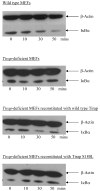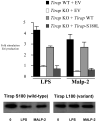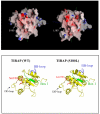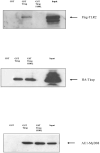A Mal functional variant is associated with protection against invasive pneumococcal disease, bacteremia, malaria and tuberculosis
- PMID: 17322885
- PMCID: PMC2660299
- DOI: 10.1038/ng1976
A Mal functional variant is associated with protection against invasive pneumococcal disease, bacteremia, malaria and tuberculosis
Abstract
Toll-like receptors (TLRs) and members of their signaling pathway are important in the initiation of the innate immune response to a wide variety of pathogens. The adaptor protein Mal (also known as TIRAP), encoded by TIRAP (MIM 606252), mediates downstream signaling of TLR2 and TLR4 (refs. 4-6). We report a case-control study of 6,106 individuals from the UK, Vietnam and several African countries with invasive pneumococcal disease, bacteremia, malaria and tuberculosis. We genotyped 33 SNPs, including rs8177374, which encodes a leucine substitution at Ser180 of Mal. We found that heterozygous carriage of this variant associated independently with all four infectious diseases in the different study populations. Combining the study groups, we found substantial support for a protective effect of S180L heterozygosity against these infectious diseases (N = 6,106; overall P = 9.6 x 10(-8)). We found that the Mal S180L variant attenuated TLR2 signal transduction.
Figures





Comment in
-
Analysis of association of the TIRAP (MAL) S180L variant and tuberculosis in three populations.Nat Genet. 2008 Mar;40(3):261-2; author reply 262-3. doi: 10.1038/ng0308-261. Nat Genet. 2008. PMID: 18305471 No abstract available.
References
-
- Akira S, Takeda K. Toll-like receptor signalling. Nat Rev Immunology. 2004;4:499–511. - PubMed
-
- Takeda K, Kaisho T, Akira S. Toll-like receptors. Annu Rev Immunol. 2003;21:335–76. - PubMed
-
- Akira S, Takeda K, Kaisho T. Toll-like receptors: critical proteins linking innate and acquired immunity. Nat Immunol. 2001;2:675–80. - PubMed
-
- Fitzgerald KA, et al. Mal (MyD88-adapter-like) is required for Toll-like receptor-4 signal transduction. Nature. 2001 Sep 6;413(6851):78–83. - PubMed
-
- Yamamoto M, et al. Essential role for TIRAP in activation of the signalling cascade shared by TLR2 and TLR4. Nature. 2002;420:324–329. - PubMed
Publication types
MeSH terms
Substances
Grants and funding
LinkOut - more resources
Full Text Sources
Other Literature Sources
Medical
Molecular Biology Databases
Research Materials

